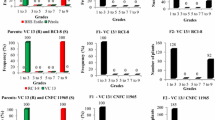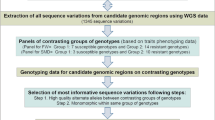Abstract
Fusarium wilt (FW) and Sterility mosaic disease (SMD) are important biotic constraints to pigeonpea production worldwide. Host plant resistance is the most durable and economical way to manage these diseases. A pigeonpea mini-core collection consisting of 146 germplasm accessions developed from a core collection of 1290 accessions from 53 countries was evaluated to identify sources of resistance to FW and SMD under artificial field epiphytotic conditions during 2007–08 and 2008–09 crop seasons. Resistant sources identified in the field were confirmed in the greenhouse using a root dip screening technique for FW and a leaf stapling technique for SMD. Six accessions (originated from India and Italy were found resistant to FW (<10% mean disease incidence). High level of resistance to SMD was found in 24 accessions (mean incidence <10%). These SMD resistant accessions originated from India, Italy, Kenya, Nepal, Nigeria, Philippines and United Kingdom. Combined resistance to FW and SMD was found in five accessions (ICPs 6739, 8860, 11015, 13304 and 14819). These diverse accessions that are resistant to FW or SMD will be useful to the pigeonpea resistance breeding program.



Similar content being viewed by others
References
Ae, N., Arihara, J., Okada, K., Yoshihara, T., & Johansen, C. (1990). Phosphorus uptake by pigeonpea and its role in cropping system of the Indian subcontinent. Current Science, 248, 477–480.
FAO STAT (2009). Food and Agriculture organization of the United Nations, Rome. http://faostat.fao.org/
Frankel, O. H. (1984). Genetic perspectives of germplasm conservation. In W. K. Arber (Ed.), Genetic manipulation: impact on man and society (pp. 161–170). Cambridge: Cambridge University Press.
Gomez, & Gomez. (1984). Statistical procedure for agricultural research (2nd ed., pp. 306–308). New York: Wiley.
Goodman, M. M. (1990). Genetic and germplasm stocks worth conserving. Journal of Hereditary, 81, 11–16.
Gwata, E. T., Silim, S. N., & Mgonja, M. (2006). Impact of a new source of resistance to Fusarium Wilt in Pigeonpea. Journal of Phytopathology, 154, 62–64.
Jain, K. C., & Reddy, M. V. (1995). Inheritance of resistance to fusarium wilt in pigeonpea (cajanus cajan (l.) millsp.). Indian Journal of Genetics, 55, 434–437.
Kannaiyan, J., Nene, Y. L., Reddy, M. V., Ryan, J. G., & Raju, T. N. (1984). Prevalence of pigeonpea diseases and associated crop losses in India, Africa, and the Americas. Tropical Pest Management, 30, 62–71.
Khare, D., Satpute, R. G., & Tiwari, A. S. (1994). Present state of the wilt and sterility mosaic diseases of pigeonpea. Indian Journal of Genetics, 54(4), 331–346.
Kulkarni, N. K., Kumar, P. L., Muniyappa, V., Jones, A. T., & Reddy, D. V. R. (2003). Broad-based resistance to pigeonpea sterility mosaic disease in the accessions of Cajanus scarabaeoides. Indian Journal of Plant Protection, 31, 6–11.
Kumar, P. L., Jones, A. T., Sreenivasulu, P., & Reddy, D. V. R. (2000). Breakthrough in the identification of the causal agent of pigeonpea sterility mosaic disease. Journal of Mycology and Plant Pathology, 30, 249.
Nene, Y. L., & Sheila, V. K. (1990). Pigeonpea: geography and importance. In Y. L. Nene, S. D. Hall, & V. K. Sheila (Eds.), The pigeonpea (pp. 1–14). Wallingford: CAB International.
Nene YL, Kannaiyan J, Reddy MV (1981) Pigeonpea diseases: Resistance-screening techniques. Information bulletin no. 9. International Crops Research Institute for the Semi Arid Tropics, Patancheru 502 324, AP, India
Nene, Y. L., Reddy, M. V., Beniwal, S. P. S., Mahmood, M., Zote, K. K., Singh, R. N., & Sivaprakasam, K. (1989). Multilocational testing of pigeonpea for broad based resistance. Indian Phytopathology, 42, 44–48.
Pande, S., Kishore, G. K., Upadhayaya, H. D., & Rao, J. N. (2006). Identification of sources of multiple disease resistance in mini- core collection of chickpea. Plant Disease, 90, 1214–1218.
Rangaswamy, K. T., Muniyappal, V., Kumar, P. L., Saxena, K. B., Byregowda, M., Raghavendra, N., Pandurangaiah, K., Kumar, R. V., Waliyar, F., & Jones, A. T. (2005). ICP 7035 – a sterility mosaic resistant vegetable and grain purpose pigeonpea variety. SAT e Journal, 1, 1–3.
Reddy MV, Nene YL, Singh G, Bashir M (1990) Strategies for management of foliar diseases of chickpea. Chickpea in the nineties: proceedings of second international workshop chickpea improvement (pp 117–127). (International Crops Research Institute for the Semi Arid Tropics, Patancheru 502 324, AP, India)
Reddy, M. V., Raju, T. N., Sharma, S. B., Nene, Y. L. & Mc Donald, D. (1993). Handbook of pigeonpea diseases. Information bulletin no. 42, ICRISAT, Hyderabad, India (ISBN 92-9066-277-8).
Reddy, M. V., Raju, T. N., & Lenne, J. M. (1998). Diseases of pigeonpea. In D. J. Allen & J. M. Lenne (Eds.), The pathology of food and posture legumes (pp. 517–558). CAB International: Wallingford.
Reddy, L. J., Upadhyaya, H. D., Gowda, C. L. L., & Singh, S. (2005). Development of core collection in pigeonpea [Cajanus cajan (L.) Millspaugh] using geographic and qualitative morphological descriptors. Genetic Resources and Crop Evolution, 52, 1049–1056.
Saxena, K. B., Kumar, R. V., & Rao, P. V. (2002). Pigeonpea nutrition and its improvement. Journal of Crop Production, 5, 227–260.
Sharma, R., Rao, V. P., Upadhyaya, H. D., Reddy, V. G., & Thakur, R. P. (2010). Resistance to grain mold and downy mildew in a mini- core collection of sorghum germplasm. Plant Disease, 94, 439–444.
Singh, L., Gupta, S. C., & Faris, D. G. (1990). Pigeonpea: breeding. In Y. L. Nene et al. (Eds.), The pigeonpea (pp. 375–399). Cambridge: CAB International, Univ. Press.
Singh, A. K., Rathi, Y. P. S., & Agarwal, K. C. (1999). Sterility mosaic of pigeonpea: A challenge of the 20th century. Indian Journal of Virology, 15, 85–92.
Upadhyaya, H. D., Reddy, L. J., Gowda, C. L. L., Reddy, K. N., & Singh, S. (2006). Development of a mini core subset for enhanced and diversified utilization of pigeonpea germplasm resources. Crop Science, 46, 2127–2132.
Van der Maesen, L. J. G. (1990). Pigeonpea: origin, history, evolution and taxonomy. In Y. L. Nene, S. D. Hall, & V. K. Sheila (Eds.), The pigeonpea (pp. 15–46). Wallingford: CAB International.
Author information
Authors and Affiliations
Corresponding author
Rights and permissions
About this article
Cite this article
Sharma, M., Rathore, A., Mangala, U.N. et al. New sources of resistance to Fusarium wilt and sterility mosaic disease in a mini-core collection of pigeonpea germplasm. Eur J Plant Pathol 133, 707–714 (2012). https://doi.org/10.1007/s10658-012-9949-9
Accepted:
Published:
Issue Date:
DOI: https://doi.org/10.1007/s10658-012-9949-9




